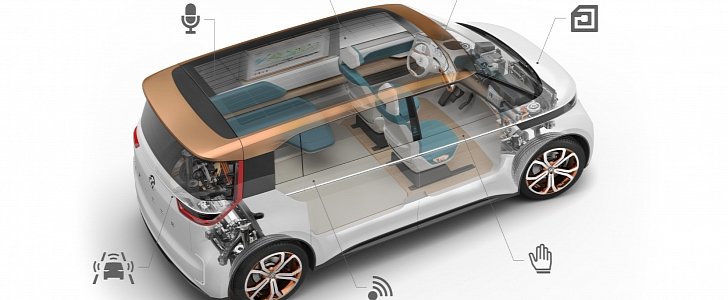Volkswagen recently revealed a concept car dubbed Budd-e, which featured a modular platform for electric vehicles.
While the Budd-e concept will not get a production version per se, the new platform will be turned into reality through a range of electric cars from Volkswagen.
However, since the MEB architecture is destined for compact cars, the German corporation is pondering the development of an extended platform, for larger electric vehicles.
For the time being, Volkswagen is still discussing if the recently announced MEB is “flexible” enough to accommodate big sedans like the Phaeton, or if the company must make a bigger platform for electric vehicles.
As some of you know, Volkswagen announced last year that it is postponing the replacement of the Phaeton, and that the flagship sedan will get an electric version when it comes back in showrooms.
Unlike the ongoing MQB, a modular platform for many models in the current Volkswagen Group portfolio, the MEB will bring a new level of flexibility.
Instead of current platforms, which restrict wheelbase, track, or seating position, the new solution from Volkswagen would not have significant impediments of this kind. Some restraints will exist, as this technical architecture is not meant to suit cars longer than the Passat.
As Automotive News notes, the Volkswagen Group has also announced it will build larger electric vehicles, like Porsche’ Mission E Concept, and the Audi e-tron quattro. There has not been an announcement of a link between the platforms of the two cars, but we know that they will not use the MEB.
Analysts wonder if the Volkswagen Group has considered a split platform for the Porsche Mission E and Audi’s e-tron quattro. If so, this result could be eventually used for the electric Phaeton.
The new MEB platform implemented scalable batteries, which are integrated into the floor of the vehicle. Depending on the planned wheelbase, total range, and other specification, engineers could add or subtract batteries to make the platform fit the car.
Since the electric engines are smaller than their internal combustion equivalents, models that exceed the D-Segment (i.e. larger than the VW Passat), could also be built on the MEB platform. What’s left for Volkswagen executives to decide is if customers would buy a large electric sedan, like the rumored Phaeton EV, in sufficient numbers to justify development of a new platform.
However, since the MEB architecture is destined for compact cars, the German corporation is pondering the development of an extended platform, for larger electric vehicles.
For the time being, Volkswagen is still discussing if the recently announced MEB is “flexible” enough to accommodate big sedans like the Phaeton, or if the company must make a bigger platform for electric vehicles.
As some of you know, Volkswagen announced last year that it is postponing the replacement of the Phaeton, and that the flagship sedan will get an electric version when it comes back in showrooms.
Unlike the ongoing MQB, a modular platform for many models in the current Volkswagen Group portfolio, the MEB will bring a new level of flexibility.
Instead of current platforms, which restrict wheelbase, track, or seating position, the new solution from Volkswagen would not have significant impediments of this kind. Some restraints will exist, as this technical architecture is not meant to suit cars longer than the Passat.
As Automotive News notes, the Volkswagen Group has also announced it will build larger electric vehicles, like Porsche’ Mission E Concept, and the Audi e-tron quattro. There has not been an announcement of a link between the platforms of the two cars, but we know that they will not use the MEB.
Analysts wonder if the Volkswagen Group has considered a split platform for the Porsche Mission E and Audi’s e-tron quattro. If so, this result could be eventually used for the electric Phaeton.
The new MEB platform implemented scalable batteries, which are integrated into the floor of the vehicle. Depending on the planned wheelbase, total range, and other specification, engineers could add or subtract batteries to make the platform fit the car.
Since the electric engines are smaller than their internal combustion equivalents, models that exceed the D-Segment (i.e. larger than the VW Passat), could also be built on the MEB platform. What’s left for Volkswagen executives to decide is if customers would buy a large electric sedan, like the rumored Phaeton EV, in sufficient numbers to justify development of a new platform.

